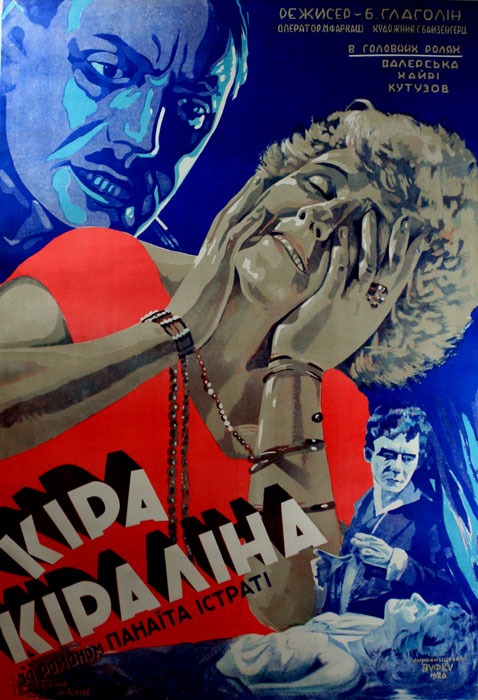+ FOUND +

Kira Kiralina
Twice Sold Woman
1927, Second Film Studio VUFKU (Yalta), 6–7 parts / 1,530–2,369 m
Olena Valerska (Kira), L. Rubina (Kiralina, Kira’s daughter), Yurii Krestynskyi (Drahomyr, Kira’s son), Oleksii Vatulia (Stavro, Kira’s husband), Nikolai Akimov (Kozma, Kira’s brother, a smuggler), Hayri Emir-zade (Nazim-Effendi, a human trafficker), A. Narovskyi (Kira’s father), Yevheniia Petrova (Kira’s mother), N. (M.?) Fedorenko (Andreio, a young Greek), Oleksandr Arbo (Siguranța security officer), Havriil Marynchak (black servant), N. (M.?) Kutuzov (Illia, Stavro’s son from the first marriage), B. Honcharov (a smuggler with an earring), Shorokhova (an old bent woman).
The film is based on Panait Istrati’s novel of the same name.
To pay off their debts, parents sell their young daughter Kira to an old coach maker, a wealthy man Stavro. When Kira is 13 years old, Stavro takes her to his home as a slave wife. Soon, they have children, Kiralina and Drahomyr. Constant humiliation forces her to indulge in treachery: Kira assists her brother Kozma in blackmailing Stavro. When her husband finds out, he beats her and the children and throws them out of the house. While Kira’s weak and unconscious, Kiralina seeks help in the wrong place and is enslaved by Nazim-Effendi, a human trafficker. Nazim kills Stavro in a fight and sells Kiralina off to an eastern brothel. Drahomyr is on his way to follow his uncle’s path in becoming a criminal, and Kira, alone and half mad, kills herself by jumping into a waterfall. «Another life, of which there are so many in the Balkans, ended grimly.»
«Yalta Film Studio crew is out there in the beautiful countryside, where the sea is splashing, changing all colours of the rainbow and blinding us with its glow below, and astonishing Southern landscape is all around us, day after day, from sunrise to sunset, looking for necessary locations for ‚Kira Kiralina‘ — moving picture as captivating as Crimean nature», «Kino» magazine reported in 1926.
Behind the movie were the leading figures of new Kharkiv theatre — Boris Glagolin (born Boris Gusev), who directed films under the Russian Empire since 1914, and Olena Valerska. When the movie was in post-production, Panait Istrati himself visited the USSR, Ukraine in particular (a photo of him in the company of Oleksandr Dovzhenko and Leonid Moguy exists). Most of the people who created «Kira» were soon to be proclaimed enemies of the Soviet nation: Glagolin became an US émigré, and Istrati openly expressed his disappointment in Soviet state after visiting it, effectively breaking up with communist orthodoxy and starting his path towards political radicalism.
«Kira Kiralina» was adapted for the screen again in 2014 by Romanian director Dan Pita.
Premiere was held on 24.04.1928 in Kyiv, 21.05.1929 in Moscow. In 1927, «Kira Kiralina» became one of thirteen VUFKU pictures chosen for distribution in Western Europe. Probably because of that, several copies of it survived; it’s worth noticing that in the version preserved in Romanian Cinematheque, the tragic ending is cut (Kira loses her children but doesn’t end her life).
Copies of the movie are preserved in National Film Archive – Romanian Cinematheque (Bucharest, 6 reels, 1510 m), Bundesarchiv of Germany (6 reels, 1538 m) and Russian Gosfilmofond (7 reels, 2369 m).